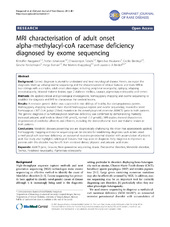MRI characterisation of adult onset alpha-methylacyl-coA racemase deficiency diagnosed by exome sequencing
Haugarvoll, Kristoffer; Johansson, Stefan; Tzoulis, Charalampos; Haukanes, Bjørn Ivar; Bredrup, Cecilie; Neckelmann, Gesche; Boman, Helge; Knappskog, Per; Bindoff, Laurence
Peer reviewed, Journal article
Published version
Date
2013-01-03Metadata
Show full item recordCollections
Original version
https://doi.org/10.1186/1750-1172-8-1Abstract
Background: Correct diagnosis is pivotal to understand and treat neurological disease. Herein, we report the diagnostic work-up utilizing exome sequencing and the characterization of clinical features and brain MRI in two siblings with a complex, adult-onset phenotype; including peripheral neuropathy, epilepsy, relapsing encephalopathy, bilateral thalamic lesions, type 2 diabetes mellitus, cataract, pigmentary retinopathy and tremor. Methods: We applied clinical and genealogical investigations, homozygosity mapping and exome sequencing to establish the diagnosis and MRI to characterize the cerebral lesions. Results: A recessive genetic defect was suspected in two siblings of healthy, but consanguineous parents. Homozygosity mapping revealed three shared homozygous regions and exome sequencing, revealed a novel homozygous c.367 G>A [p.Asp123Asn] mutation in the α-methylacyl-coA racemase (AMACR) gene in both patients. The genetic diagnosis of α-methylacyl-coA racemase deficiency was confirmed by demonstrating markedly increased pristanic acid levels in blood (169 μmol/L, normal <1.5 μmol/L). MRI studies showed characteristic degeneration of cerebellar afferents and efferents, including the dentatothalamic tract and thalamic lesions in both patients. Conclusions: Metabolic diseases presenting late are diagnostically challenging. We show that appropriately applied, homozygosity mapping and exome sequencing can be decisive for establishing diagnoses such as late onset α-methylacyl-coA racemase deficiency, an autosomal recessive peroxisomal disorder with accumulation of pristanic acid. Our study also highlights radiological features that may assist in diagnosis. Early diagnosis is important as patients with this disorder may benefit from restricted dietary phytanic and pristanic acid intake.
Publisher
BioMed CentralJournal
Orphanet Journal of Rare DiseasesCopyright
Kristoffer Haugarvoll et al.; licensee BioMed Central Ltd.Copyright 2013 Haugarvoll et al.; licensee BioMed Central Ltd.

